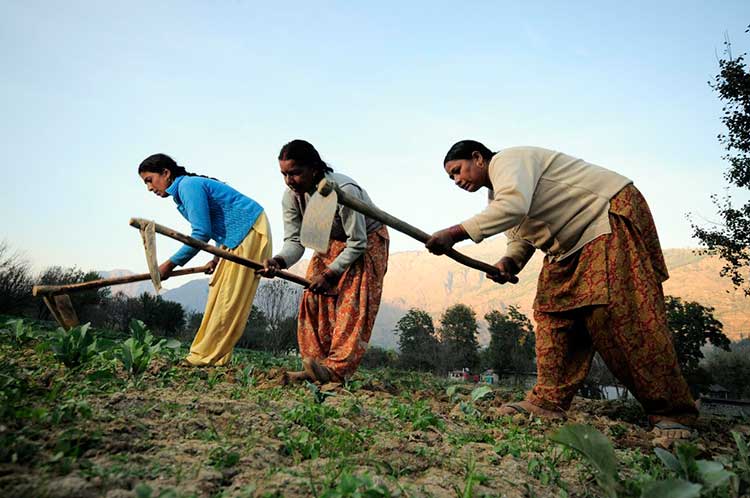If one questions — what do women know about farming and agriculture, the answer will be pretty much everything. Women’s contribution to agriculture all across the world is exemplary. According to United Nation’s Food and Agricultural Organisation, if women had the same access to productive resources as men, they could increase yields on their farms by 20-30%. Nevertheless women continue to be invisible in the discourse on farmers’ suicides, agricultural crisis etc.

India recently witnessed massive farmers’ rally demanding relief. One dominant feature of these rallies was the presence of women farmers in large number. Their split, cracked bloody feet which bore witness to their hardships left many across the country stunned. While most mainstream news channels downplayed the importance of these rallies and emphasised on other trivial matters, few channels did manage to put a spotlight on them and focussed more on the plight of women farmers. Women farmers across the states shared similar stories and most had to do with non-recognition of women as farmers.
The country continues to witness agrarian crisis of an immense nature. While the government policies fall short of providing any relief to the farmers, noted journalist P Sainath points out that the Fasal Bima Yojana is a total sham and benefits only the insurance companies and banks. The farmers are left out of its ambit. And the picture of farming crisis continues to be grim.
Maharashtra’s Vidarbha continues to be a region with a very high number of suicide cases. Over the last two decades, more than two lakh farmers committed suicide. Flawed insurance plans and delays in settling claims have worsened the distress. There is an increase in the number of households headed by women. There is a feminisation of agriculture with the number of female agricultural labourers in Maharashtra, Tripura and Kerala seeing an upward trend since 1961.
The Wire came out with a report titled “Surviving Stigma: Housing and Land Rights of Farm Widows of Vidarbha, Maharashtra”. It highlighted the plight of farm widows and the repeated human rights violation and economic exclusion. Nearly 90% of the women farmers lived in joint families indicating financial dependence on the in-laws. They complained of physical and emotional abuse upon demanding their share in the family house or land. On many instances, they faced social ostracisation. Most women are even unaware of their rights or are incapable of benefitting from the policies aimed at helping them.
Vidarbha once known for production of “white gold” or cotton is now known mainly for farmers’ suicides. In nearby Marathwada, a debt of as less as Rs 10,000 can push someone to suicide. The widows are pushed into more debts and forced to take job as farm labourers on other’s farms to sustain themselves. The education of their children is stopped midways.
Kota Neelima’s upcoming book “Widows of Vidarbha” gives an account of such women. For widows left behind, to die seemed easier than to live. Women farmers are usually rendered invisible in spaces of policy making. Farmers’ suicides are thrown around as statistics, used as propaganda, referenced in campaign speeches and dismissed as political ploy of the opposition.
In 2015, data reveals that 98 million women in India work in agricultural sector but debate around farmer’s suicides often revolve around men because women don’t own property and hence don’t qualify as farmers. Only 13% women own the land that they work on. Their status is worse than workers. While 60-80% of all agricultural work is done by women, they are just given the status of farm workers.
Added domestic responsibility does not free women of difficult jobs like sowing, seeding, threshing, harvesting, ploughing etc. Even at the local galla mandis, women farmers face serious discrimination. They are offered raw deals and often face sexual harassment.
There is already a spike in farmer suicides. Farmer suicides rose by 42% between 2014 and 2015. Out of the 8007 farmer suicides in 2014, 441 were by women farmers and cultivators.
The empowerment of Indian women will not be complete without empowering those who are living at the society’s periphery. These voices need to be heard at both the policy level and the implementation level.
An increasing male migration away from villages has brought about significant changes to the work village women do, both at the household and societal level. Migration has redefined women’s role in agriculture.
Women farmers need direct access to information on improved agricultural practices and links to markets. One positive step is marking October 15 as Women Farmers’ Day. But it has to be supplemented by policies. Lack of land rights is a big problem. They are unable to avail any benefit of government policies. The need of the hour is to change inheritance practices and give land rights to daughters as well.
A patriarchal social set up conveniently co-opts women’s agricultural labour but falls short of giving her the status of farmers. Women farmers’ rights need to be recognised as farming was never exclusively a man’s work. Policy benefits also should extend automatically to the wives of the farmers who commit suicide. While the overall agrarian crisis needs to be tackled with utmost urgency, the gendered aspect should also be looked into. Otherwise the women farmers will continue to be one of the most marginalised lot in India.
Parvin Sultana is an Assistant Professor in P B College of Assam. Her research interest includes Muslims in Assam, development and northeast, gender etc. She can be reached at parvin.jnu@gmail.com
Courtesy: https://countercurrents.org/
